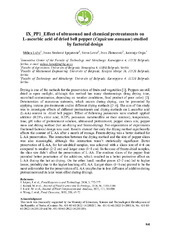Приказ основних података о документу
Effect of ultrasound and chemical pretreatments on L-ascorbic acid of dried bell pepper (Capsicum annuum) studied by factorial design
| dc.creator | Lučić, Milica | |
| dc.creator | Sredović Ignjatović, Ivana | |
| dc.creator | Lević, Steva | |
| dc.creator | Zlatanović, Ivan | |
| dc.creator | Onjia, Antonije | |
| dc.date.accessioned | 2023-03-24T12:33:29Z | |
| dc.date.available | 2023-03-24T12:33:29Z | |
| dc.date.issued | 2022 | |
| dc.identifier.isbn | 978‐86‐7834‐408‐4 | |
| dc.identifier.uri | http://TechnoRep.tmf.bg.ac.rs/handle/123456789/6321 | |
| dc.description.abstract | Drying is one of the methods for the preservation of fruits and vegetables [1]. Peppers are still dried in open sunlight, although this method has many shortcomings (long drying time, microbial contamination, depending on weather conditions, final product of poor color) [2]. Deterioration of numerous nutrients, which occurs during drying, can be prevented by applying various pre-treatments and/or different drying methods [2–4]. The aim of this study was to investigate effects of different pretreatments and drying methods on L-ascorbic acid (L-AA) content in dried bell pepper. Effect of following parameters were studied: applied additive (0.25% citric acid, 0.25% potassium metabisulfite or their mixture), temperature, time, pH value of pretreatment solution, ultrasound pretreatment, pepper slices size, pepper mass and drying method (hot air-drying and freeze-drying). For organization of experiments fractional factorial design was used. Results showed that only the drying method significantly affects the content of L-AA after a month of storage. Freeze-drying was a better method for L-AA preservation. The interaction between the drying method and the size of pepper slices was also meaningful, although this interaction wasn’t statistically significant. Better preservation of L-AA, for hot air-dried samples, was achieved with a slices size of 4×4 cm compared to smaller (2×2 cm) and larger ones (8×8 cm). In the case of freeze-dried samples, the slice size didn’t affect the preservation of L-AA. The medium slices of the pepper fruit provided better penetration of the additives, which resulted in a better protective effect on L-AA during the hot air-drying. On the other hand, smaller pieces (2×2 cm) led to higher losses, probably due to the higher leaching of L-AA. Larger slices (8×8 cm) proved to be the most unfavorable for the preservation of L-AA (maybe due to less diffusion of additive during pretreatment and its later weak effect during drying). | sr |
| dc.language.iso | en | sr |
| dc.publisher | University of Belgrade‐Faculty of Agriculture | sr |
| dc.relation | info:eu-repo/grantAgreement/MESTD/inst-2020/200287/RS// | sr |
| dc.relation | info:eu-repo/grantAgreement/MESTD/inst-2020/200116/RS// | sr |
| dc.relation | info:eu-repo/grantAgreement/MESTD/inst-2020/200135/RS// | sr |
| dc.relation | info:eu-repo/grantAgreement/MESTD/inst-2020/200105/RS// | sr |
| dc.rights | openAccess | sr |
| dc.rights.uri | https://creativecommons.org/licenses/by/4.0/ | |
| dc.source | Book of Abstracts 1st EUROPEAN SYMPOSIUM ON PHYTOCHEMICALS IN MEDICINE AND FOOD | sr |
| dc.title | Effect of ultrasound and chemical pretreatments on L-ascorbic acid of dried bell pepper (Capsicum annuum) studied by factorial design | sr |
| dc.type | conferenceObject | sr |
| dc.rights.license | BY | sr |
| dc.citation.spage | 84 | |
| dc.identifier.fulltext | http://TechnoRep.tmf.bg.ac.rs/bitstream/id/16899/1-EuSPMF_Abstracts_101.pdf | |
| dc.identifier.rcub | https://hdl.handle.net/21.15107/rcub_technorep_6321 | |
| dc.type.version | publishedVersion | sr |

